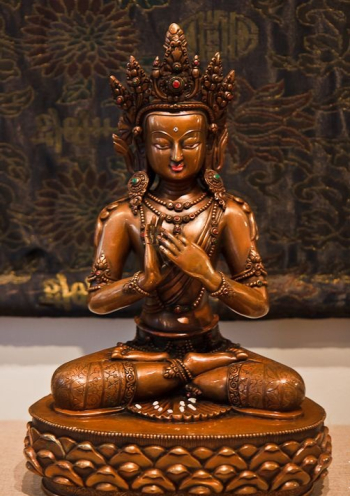Mantra of Light
The Mantra of Light, also called the Mantra of the Unfailing Rope Snare, is an important mantra of the Shingon and Kegon schools of Buddhism, but is not emphasized in other Vajrayāna sects of Buddhism.
It is taken from the Amoghapāśakalparāja-sūtra or Sūtra of the Mantra of the Unfailing Rope Snare of the Buddha Vairocana's Great Salvation and is chanted as follows:
Devanāgarī:
ॐ अमोघ वैरोचन महामुद्रा मणिपद्म ज्वाल प्रवर्ताय हूँ
Oṁ Amogha Vairocana Mahāmudrā Maṇipadma Jvāla Pravartāya Hūṁ
The translation of this mantra is roughly:
Praise be to the flawless, all-pervasive illumination of the great mudra (or seal of the Buddha). Turn over to me the jewel, lotus and radiant light.
In its syllables, the entire power of the omnipresent Mahāvairocana (Dainichi Buddha) manifests. When we recite this mantra earnestly; the Light of the Buddha will embrace us. Illusions will disappear spontaneously, as the moon becomes free from mist.
When you recite this mantra, visualize a moon disc in your heart, with a golden Sanskrit seed syllable Ā (अ:) on it.
This syllable Ā (अ:) radiates light and illuminates on all sentient beings. Anyone in contact with this light will be liberated from suffering and receive joy.
It is as good as receiving a jewel, a lotus, a rebirth and illumination, where liberation is instantaneous and all vows are fulfilled.
Initially, the mantra received little mention in East Asian Buddhist texts, and although Kūkai brought the sūtra to Japan in the 9th century, there are no records that he ever utilized it in tantric practices.
Records show gradually increasing use in the Heian Period, until the 13th century when it was popularized in medieval Japanese Buddhism by Myōe, and later by Shingon monks Eison and Ninshō in their service.
Both the Mantra of Light and the Nembutsu were often incorporated by Medieval Buddhists at one time or another, often in the same service.
A common practice for the Mantra of Light was to sprinkle pure sand, blessed with this mantra, on the body of a deceased person or their tomb, according to the teachings expounded in the Sūtra.
The belief was that a person who had accumulated much bad karma and possible rebirth in Hell would be immediately freed and allowed a favourable rebirth into the Pure Land of Amitābha Buddha. This practice is known as dosha-kaji in Japanese.
The Sūtra of the Mantra of the Unfailing Rope Snare of the Buddha Vairocana’s Great Salvation states that if any sentient being would commit the 10 evil ways, the 5 deadly sins and upon his death descend to the lower realm, by reciting this mantra 108 times, the deceased would ascend to the Western Pure Land of Amitābha!
The sūtra also states that if any sentient being would listen to this mantra 2 times, 3 times or 7 times, all his karmic hindrances would be eradicated.
Myōe (1173–1232) was a Japanese Buddhist monk active during the Kamakura period and contemporary of Jōkei and Hōnen.
Myōe is perhaps most famous for his contributions to the practice and popularization of the Mantra of Light, a mantra associated with Shingon Buddhism but widely used in other Buddhist sects.
He was ordained in both Kegon and Shingon traditions of Japanese Buddhism, which was not uncommon for monks in medieval Japan.
In the latter half of his career he served as abbot of Kōzan-ji, a temple of the Kegon School located near Kyoto.
During his lifetime he was a scathing critic of his contemporary Hōnen, and the new Pure Land Buddhist movement.
As a response to the increasing popularity of the exclusive Nembutsu practice, Myōe wrote 2 treatises, the Zaijarin ("Tract for Destroying Heretical Views") and the follow-up Zaijarin Shōgonki ("Elaboration of the Zaijarin") that sought to refute Hōnen's teachings as laid out in the Senchaku-shū.
Myōe agreed with Hōnen's criticism of the establishment, but felt that sole practice of the Nembutsu was too restrictive and disregarded important Buddhist themes in Mahāyāna Buddhism such as the Bodhicitta and the concept of Upāya.
In the later years of his life, Myōe wrote extensively on the meaning and application of the Mantra of Light:
Myōe's interpretation of the Mantra of Light was somewhat unorthodox, in that he promoted the mantra as a means of being reborn in Sukhāvatī, the Pure Land of Amitābha, rather than a practice for attaining Enlightenment in this life as taught by Kūkai and others.
Myōe was a firm believer in the notion of Dharma Decline and sought to promote the Mantra of Light as a means to overcome the negativities of the Dark Age.
Records for the time show that the daily regimen of practices for the monks at Kōzan-ji, during Myōe’s administration, included Zazen meditation, recitation of the Sūtras and the Mantra of Light.
